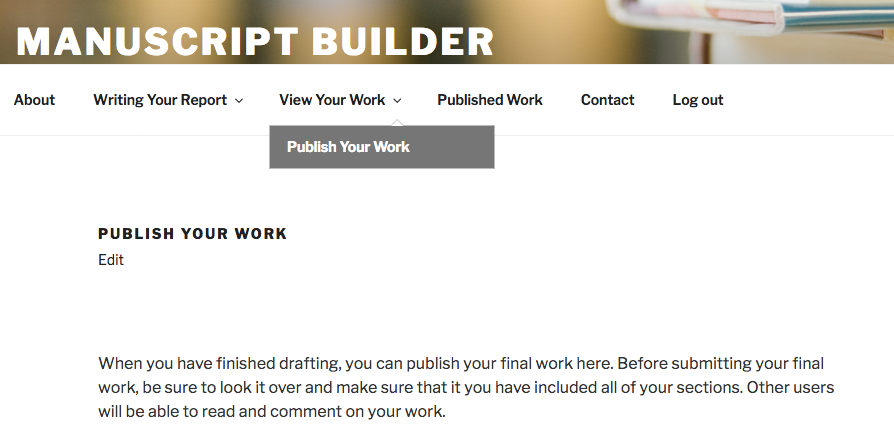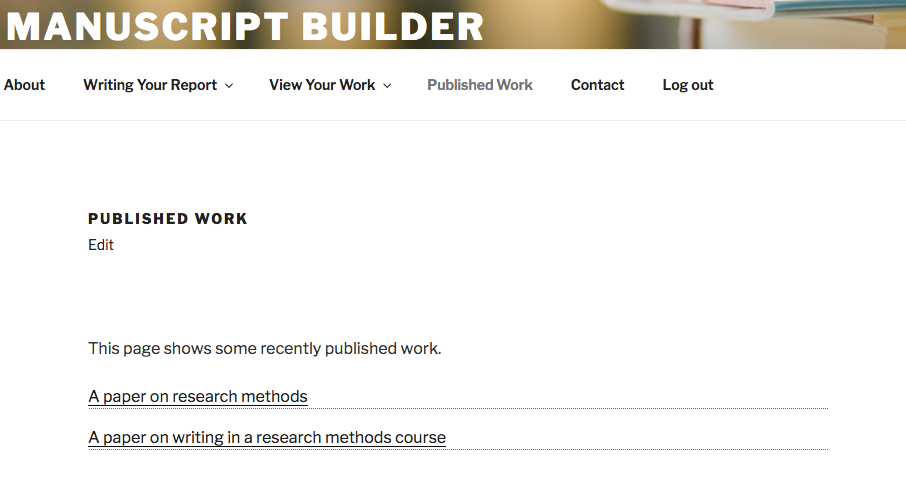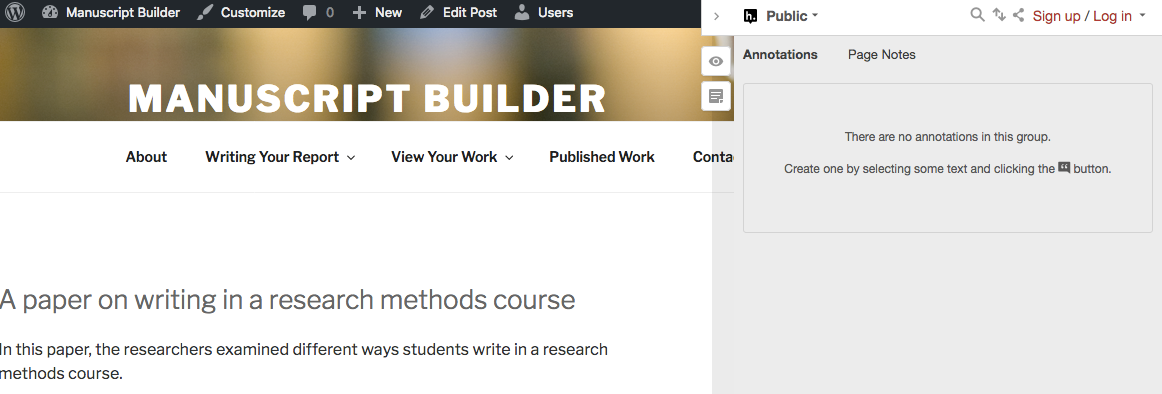By Teresa Ober, Ph.D. Candidate, The Graduate Center CUNY
Many students appear to struggle with writing tasks in college for at least several reasons. In college, there is typically a higher demand for high-quality writing across many college-level courses and disciplines (Oppenheimer, Zaromb, Pomerantz, Williams, & Park, 2017). In addition, for a student who is unfamiliar with a topic, writing may be particularly straining on attention and memory capacities (Kellogg, 2001; Kellogg, Olive, & Piolat, 2007). Although practice, along with adequate feedback, is considered essential for improving one’s writing (Graham & Perin, 2007), there may be few opportunities for college students to practice writing not tied to their grades. From the instructor’s perspective, however, managing time necessary to provide adequate feedback to students on written work through detailed commentary on their initial drafts is not always feasible. In light of these challenges, Manuscript Builder was designed to provide structure through a set of ordered prompts to support students' writing. In the latest iteration of the tool, it now also provides a platform for conducting peer reviews.
Prior studies have shown that student-led peer review can be effective at improving students’ writing skills (Topping, 1998; Van Zundert, Sluijsmans, & Van Merriënboer, 2010), tends to be valid and reliable assessment of student work (Cho, Schunn, & Wilson, 2006), and is viewed both as motivational and meaningful by students (Hanrahan & Isaacs, 2001). Student-led peer review is also effective when conducted through a computer-mediated format (Cho & Schunn, 2007).
Student-led peer review can be conducted through an online tool available to instructors and students. As a pedagogical tool, Manuscript Builder is designed to facilitate the planning and outlining process by providing a purpose, a text structure, and prompts to guide students in drafting a written research report. The user can navigate between pages, with most representing a specific section that would appear in the final written report (e.g., Introduction, Methods, Results and Data Analysis, Discussion, References). Each page contains a set of prompts and an input text field. Users can create an account on the site and return to previously drafted work by logging-in at any time. When users have finished writing responses to prompts, they can copy their responses and share as a finalized post. The finalized post can then be used for further writing, editing, student-led peer review, and finally, publishing on the site. The steps below outline the process for adding a manuscript and conducting a peer review.
Instruction around writing, and communication more generally, remains an essential component of the undergraduate curriculum, regardless of students’ majors. Direct writing instruction for undergraduate students has benefits for learning (Graham & Perin, 2007). It also stands as a core goal of the APA Guidelines for the Undergraduate Major, version 2.0 (APA, 2016). By leveraging peer-feedback, Manuscript Builder helps to facilitate student-led peer-review processes, which may be one effective means by which to provide students an engaging and collaborative activity to promote their writing skills.
Steps for Conducting a Peer-review Activity in Manuscript Builder
Instructions for Creating Your Manuscript Builder Account
1) Log-in to your computer and open a web-browser.
2) Go to the URL: https://manuscriptbuilder.newmedialab.cuny.edu/register/

3) Enter your first and last name, the class code your instructor gave you, a username, your email, and a password that you will remember.

Instructions for Publishing Your Report
1) Once you are logged-in, go to the “Publish Your Work” page (URL: https://manuscriptbuilder.newImedialab.cuny.edu/post-form-page/).

2) Add the title for your report and copy-and-paste the main body of your report.
3) When you are ready, just click the button at the bottom of the page.
4) You can always return to your drafts by going to the “View Your Work” page (URL: https://manuscriptbuilder.newmedialab.cuny.edu/view/). On this page you can choose to continue editing your draft or delete it entirely.

Instructions for Review: Conducting a Peer-Review
1) Go to the “Published Work” page (URL: https://manuscriptbuilder.newmedialab.cuny.edu/published/).

2) There you should see a list of published reports.
3) Click on one.
4) After you are redirected to that page, you should see a side-bar open up on the right side like this image below.

5) Log-in to Hypothesis with your Hypothesis account information. (Note that this is a separate log-in from your Manuscript Builder account.)

6) Once logged in, you can begin commenting on your peer’s work!
References
Cho, K., & Schunn, C. D. (2007). Scaffolded writing and rewriting in the discipline: A web-based reciprocal peer review system. Computers & Education, 48(3), 409–426.
Cho, K., Schunn, C. D., & Wilson, R. W. (2006). Validity and reliability of scaffolded peer assessment of writing from instructor and student perspectives. Journal of Educational Psychology, 98(4), 891.
Graham, S., & Perin, D. (2007). A meta-analysis of writing instruction for adolescent students. Journal of Educational Psychology, 99(3), 445–476.
Hanrahan, S. J., & Isaacs, G. (2001). Assessing self-and peer-assessment: The students' views. Higher Education Research & Development, 20(1), 53–70.
Kellogg, R. T. (2001). Competition for working memory among writing processes. The American Journal of Psychology, 114(2), 175–191.
Kellogg, R. T., Olive, T., & Piolat, A. (2007). Verbal, visual, and spatial working memory in written language production. Acta Psychologica, 124(3), 382–397.
Oppenheimer, D., Zaromb, F., Pomerantz, J. R., Williams, J. C., & Park, Y. S. (2017). Improvement of writing skills during college: A multi-year cross-sectional and longitudinal study of undergraduate writing performance. Assessing Writing, 32, 12–27.
Topping, K. (1998). Peer assessment between students in colleges and universities. Review of Educational Research, 68(3), 249–276.
Van Zundert, M., Sluijsmans, D., & Van Merriënboer, J. (2010). Effective peer assessment processes: Research findings and future directions. Learning and Instruction, 20(4), 270–279.
Teresa Ober is a doctoral candidate in Educational Psychology at the Graduate Center of the City University of New York. Teresa designed and created Manuscript Builder in completion of the certificate program in Interactive Technology and Pedagogy at the Graduate Center. She is interested in the role of executive functions in language and literacy. Her research has focused on the development of cognition and language skills, as well as how technologies, including digital games, can be used to improve learning.
